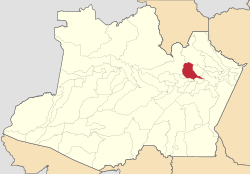
Back Manaus Afrikaans ماناوس Arabic Manaus AST Manaus Azerbaijani Manausos BAT-SMG Манаус Byelorussian Манаўс BE-X-OLD Манаус Bulgarian মানাউশ Bengali/Bangla মানাউস BPY
Manaus | |
|---|---|
| Município de Manaus Municipality of Manaus | |
Skyline with the Arena da Amazônia | |
| Nickname(s): A Paris dos Trópicos (The Paris of the Tropics); Mãe dos Deuses (Mother of the Gods) | |
| Motto: "A metrópole da Amazônia" (The metropolis of the Amazon) | |
 Location in the state of Amazonas | |
| Coordinates: 3°7′8″S 60°1′18″W / 3.11889°S 60.02167°W | |
| Country | |
| Region | North |
| State | Amazonas |
| Founded | October 24, 1669 |
| Government | |
| • Mayor | David Almeida (Avante) |
| Area | |
| • Metropolis | 11,401.092 km2 (4,401.97 sq mi) |
| • Urban | 427 km2 (165 sq mi) |
| Elevation | 92 m (302 ft) |
| Population (2020)[1] | |
| • Metropolis | 2,219,580 (7th) |
| • Density | 191.45/km2 (450.29/sq mi) |
| • Metro | 2,676,936 (11th) |
| Demonym(s) | Manauara, Manauense |
| GDP (PPP, constant 2015 values) | |
| • Year | 2023 |
| • Total (Metro) | $37.4 billion[2] |
| • Per capita | $16,400 |
| Time zone | UTC−4 (AMT) |
| Postal code | 69000-001 to 69099-999 and 69400-000 to 69899-999 |
| Area code | +55 (92) |
| HDI (2010) | 0.737 – high[3] |
| Website | www |
Manaus (Portuguese: [mɐˈnaws, ma-]) is the capital and largest city of the Brazilian state of Amazonas. It is the seventh-largest city in Brazil, with an estimated 2020 population of 2,219,580 distributed over a land area of about 11,401 km2 (4,402 sq mi). Located at the east centre of the state, the city is the centre of the Manaus metropolitan area and the largest metropolitan area in the North Region of Brazil by urban landmass. It is situated near the confluence of the Negro and Amazon rivers. It is one of the two cities in the Amazon Rainforest with a population of over 1 million people, alongside Belém.
The city was founded in 1669 as the Fort of São José do Rio Negro. It was elevated to a town in 1832 with the name of "Manaus", an altered spelling of the indigenous Manaós peoples, and legally transformed into a city on October 24, 1848, with the name of Cidade da Barra do Rio Negro, Portuguese for "The City of the Margins of the Black River". On September 4, 1856, it returned to its original name.[4]
Manaus is located in the center of the Amazon rainforest, and home to the National Institute of Amazonian Research, being the most important center for scientific studies in the Amazon region and for international sustainability issues.[5] It was known at the beginning of the century as Heart of the Amazon and City of the Forest.[6] Currently, its main economic engine is the Industrial Park of Manaus, a Free Economic Zone.[7] The city has a free port and an international airport. Its manufactures include electronics, chemical products, and soap; there are distilling and ship construction industries. Manaus also exports Brazil nuts, rubber, jute, and rosewood oil. It has a cathedral, opera house, zoological and botanical gardens, an eco-park, and regional and native peoples museums.[8]
The Solimões and Negro rivers meet just east of Manaus and join to form the Amazon River (using the Brazilian definition of the river; elsewhere, Solimões is considered the upper part of the Amazon[9]). Rubber made it the richest city in South America during the late 1800s. Rubber also helped Manaus earn its nickname, the Paris of the Tropics. Many wealthy European families settled in Manaus and brought their love for sophisticated European art, architecture, and culture with them. Manaus was one of the twelve Brazilian host cities of the 2014 World Cup, as well as one of the five subsections of the 2016 Summer Olympics.
- ^ "IBGE 2020". Archived from the original on 2020-12-30. Retrieved 2021-01-04.
- ^ "TelluBase—Brazil Fact Sheet (Tellusant Public Service Series)" (PDF). Tellusant. Retrieved 2024-01-11.
- ^ "Archived copy" (PDF). United Nations Development Programme (UNDP). Archived from the original (PDF) on July 8, 2014. Retrieved August 1, 2013.
{{cite web}}: CS1 maint: archived copy as title (link) - ^ "About Manaus". Archived from the original on 1 July 2009.
- ^ "National Institute for Amazonia Research (INPA)". eubon.eu. Archived from the original on 2019-07-14. Retrieved 2019-07-14.
- ^ Heart of The Amazon and City of the Forest Archived 2009-06-14 at the Wayback Machine
- ^ "Manaus, Brazil - Amazon River Cruise Ship Port of Call". TripSavvy. Archived from the original on 2018-09-11. Retrieved 2019-02-05.
- ^ "Manaus - Encyclopedia.com". www.encyclopedia.com. Archived from the original on 2019-02-07. Retrieved 2019-02-05.
- ^ "Where Does the Amazon River Begin?". National Geographic News. 15 February 2014. Archived from the original on 27 March 2019. Retrieved 5 February 2019.
© MMXXIII Rich X Search. We shall prevail. All rights reserved. Rich X Search










